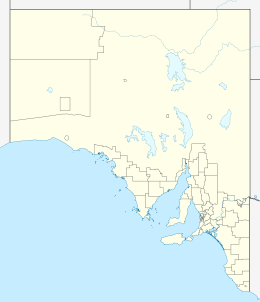Normanville, South Australia
| Normanville South Australia | |||||||||||||
|---|---|---|---|---|---|---|---|---|---|---|---|---|---|
 Normanville | |||||||||||||
| Coordinates | 35°27′0″S 138°19′0″E / 35.45000°S 138.31667°ECoordinates: 35°27′0″S 138°19′0″E / 35.45000°S 138.31667°E | ||||||||||||
| Population | 864 (2006 census)[1] | ||||||||||||
| Established | 1850 | ||||||||||||
| Postcode(s) | 5204 | ||||||||||||
| LGA(s) | District Council of Yankalilla | ||||||||||||
| Region | Fleurieu and Kangaroo Island[2] | ||||||||||||
| County | County of Hindmarsh[3] | ||||||||||||
| State electorate(s) | Finniss[4] | ||||||||||||
| Federal Division(s) | Mayo[5] | ||||||||||||
| |||||||||||||
| Footnotes | Adjoining localities[3] | ||||||||||||
Normanville is a coastal town in the Australian state of South Australia on the west coast of the Fleurieu Peninsula.
Location and geography
Normanville is 77 km south of Adelaide, South Australia. It is the largest regional centre on the western side of the Fleurieu Peninsula. It is situated next to the mouth of the Bungala River.
History
The town was established by South Australia's first dentist, Robert Norman, in 1849. General houses for people were built first, followed by the general store, and the hotel. This was quickly followed by the local Government House, which housed the Police Officer, court house, and jail cells. Norman opened the Normanville Hotel in 1851 and a church soon after. The Normanville Hotel became the host of the first district council meeting for the area. The town eventually grew to become a successful wheat exporting area, using the nearby jetty at the current Normanville Beach as a port for ships coming and going. However, with the development of Adelaide as the capital city, it lost its prior importance.
Heritage listings
Normanville includes the following sites listed on the South Australian Heritage Register:
- 18 Main South Road: Normanville Wesleyan Cemetery[6]
- Little Gorge Beach, Main South Road: Dickson Beach House[7]
- Williss Drive: Ferguson's Flour Mill[8]
- Normanville Coastal Dunes[9][10][11]
Economy
Normanville's economy is primarily based on and driven by tourism, although primary production is still active in the area. The Normanville Beach, jetty, historic buildings and the Normanville Hotel are the main focal points for visitors. Normanville is situated in the Southern Fleurieu wine region.
See also
References
- ↑ Australian Bureau of Statistics 2006 Census - Normaville (Urban Centre/Locality)
- ↑ "Limestone Coast SA Government region" (PDF). The Government of South Australia. Retrieved 9 September 2016.
- 1 2 "Search result for "Normanville (LOCB)" (Record no. SA0050431) with the following layers selected - "Suburbs and Localities" and " Place names (gazetteer)"". Property Location Browser. Government of South Australia. Retrieved 12 September 2016.
- ↑ "District of Finniss Background Profile". ELECTORAL COMMISSION SA. Retrieved 2 August 2015.
- ↑ "Federal electoral division of Mayo, boundary gazetted 16 December 2011" (PDF). Australian Electoral Commission. Retrieved 2 August 2015.
- ↑ "Normanville Wesleyan Cemetery". South Australian Heritage Register. Government of South Australia. Retrieved 12 September 2016.
- ↑ "Dickson Beach House". South Australian Heritage Register. Government of South Australia. Retrieved 12 September 2016.
- ↑ "Former Ferguson's Flour Mill". South Australian Heritage Register. Government of South Australia. Retrieved 12 September 2016.
- ↑ "Normanville Coastal Dunes". South Australian Heritage Register. Government of South Australia. Retrieved 12 September 2016.
- ↑ "Normanville Coastal Dunes Geological Site - First Additional Area". South Australian Heritage Register. Government of South Australia. Retrieved 12 September 2016.
- ↑ "Normanville Coastal Dunes Geological Site - Second Additional Area". South Australian Heritage Register. Government of South Australia. Retrieved 12 September 2016.